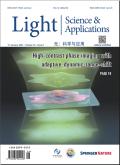Transverse mode coupling in monolithic few-mode fiber laser oscillators.
IF 23.4
Q1 OPTICS
引用次数: 0
Abstract
Transverse mode instability (TMI), induced by nonlinear thermal-optical coupling, poses a primary challenge for the power scaling of fiber lasers. In the fiber oscillator, a sealed resonant cavity, TMI could become particularly complex due to the mode competition during the laser oscillation. While traditional theories of TMI predominantly address two-mode coupling, this paper explores the TMI phenomena in few-mode fiber oscillators utilizing a holistic approach that includes solving steady-state thermal-optic coupling equations. The simulation shows that there is a non-monotonic correlation between bending loss and the TMI threshold, which is contrary to the monotonic associations suggested by two-mode interaction theory. When one high-order mode experiences net gain, fluctuations of the TMI threshold would occur, leading to the amplification of a new mode within the uncoupled frequency region, thus affecting the gain saturation. By designing the linewidth of a low-reflection grating (LR), the modal power management in the uncoupled frequency domain can be achieved. An excessively broad LR linewidth exacerbates mode coupling within the shared frequency region, thus exacerbating TMI. To validate the theoretical simulation, we carefully fabricated LRs and optimized the fiber coiling to elevate the TMI threshold. Through careful optimization of LR linewidth and bending radii, we achieved a record-breaking laser output of 10.07 kW using a monolithic fiber oscillator, with no observable evidence of TMI. Our work demonstrates that modal power redistribution in independent frequency domains offers a novel approach to mitigating TMI in high-power fiber lasers. Additionally, it provides new insights into mode decoupling strategies pertinent to fiber communications.单片少模光纤激光振荡器的横模耦合。
非线性热光耦合引起的横向模不稳定性(TMI)是光纤激光器功率缩放的主要挑战。在光纤振荡器这种密封谐振腔中,由于激光振荡过程中的模式竞争,TMI会变得特别复杂。虽然传统的TMI理论主要解决双模耦合问题,但本文利用包括求解稳态热光耦合方程在内的整体方法探讨了少模光纤振荡器中的TMI现象。仿真结果表明,弯曲损失与TMI阈值之间存在非单调相关关系,这与双模相互作用理论提出的单调关联相反。当一个高阶模态经历净增益时,TMI阈值会发生波动,导致非耦合频率区域内的新模态被放大,从而影响增益饱和。通过设计低反射光栅的线宽,可以实现非耦合频域的模态功率管理。过宽的LR线宽加剧了共享频率区域内的模式耦合,从而加剧了TMI。为了验证理论模拟,我们精心制作了LRs,并优化了光纤缠绕以提高TMI阈值。通过仔细优化LR线宽和弯曲半径,我们使用单片光纤振荡器实现了创纪录的10.07 kW激光输出,没有观察到TMI的证据。我们的工作表明,模态功率在独立频域的重新分配提供了一种新的方法来减轻高功率光纤激光器中的TMI。此外,它还提供了与光纤通信相关的模式解耦策略的新见解。
本文章由计算机程序翻译,如有差异,请以英文原文为准。
求助全文
约1分钟内获得全文
求助全文
来源期刊

Light-Science & Applications
数理科学, 物理学I, 光学, 凝聚态物性 II :电子结构、电学、磁学和光学性质, 无机非金属材料, 无机非金属类光电信息与功能材料, 工程与材料, 信息科学, 光学和光电子学, 光学和光电子材料, 非线性光学与量子光学
自引率
0.00%
发文量
803
审稿时长
2.1 months
 求助内容:
求助内容: 应助结果提醒方式:
应助结果提醒方式:


